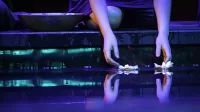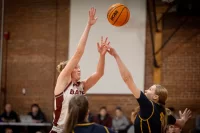
Earlier this year Golf Digest was looking for college golfers to star in a video that would showcase how a new Adobe tool could be used by lovers of the sport.
There are 1,300 men’s and women’s college golf programs in the U.S. but typically the talent pipeline for pro golf — and its preeminent publication — runs through powerhouse NCAA Division I schools such as Oklahoma State, Stanford, and Wake Forest.
For this video production though, Golf Digest turned to Division III and Bates College. To demonstrate the creative reach and user-friendly qualities of Firefly, Adobe’s generative AI tool, Golf Digest followed members of the Bates men’s and women’s golf teams as they explored its potential applications to build idealized golf holes.
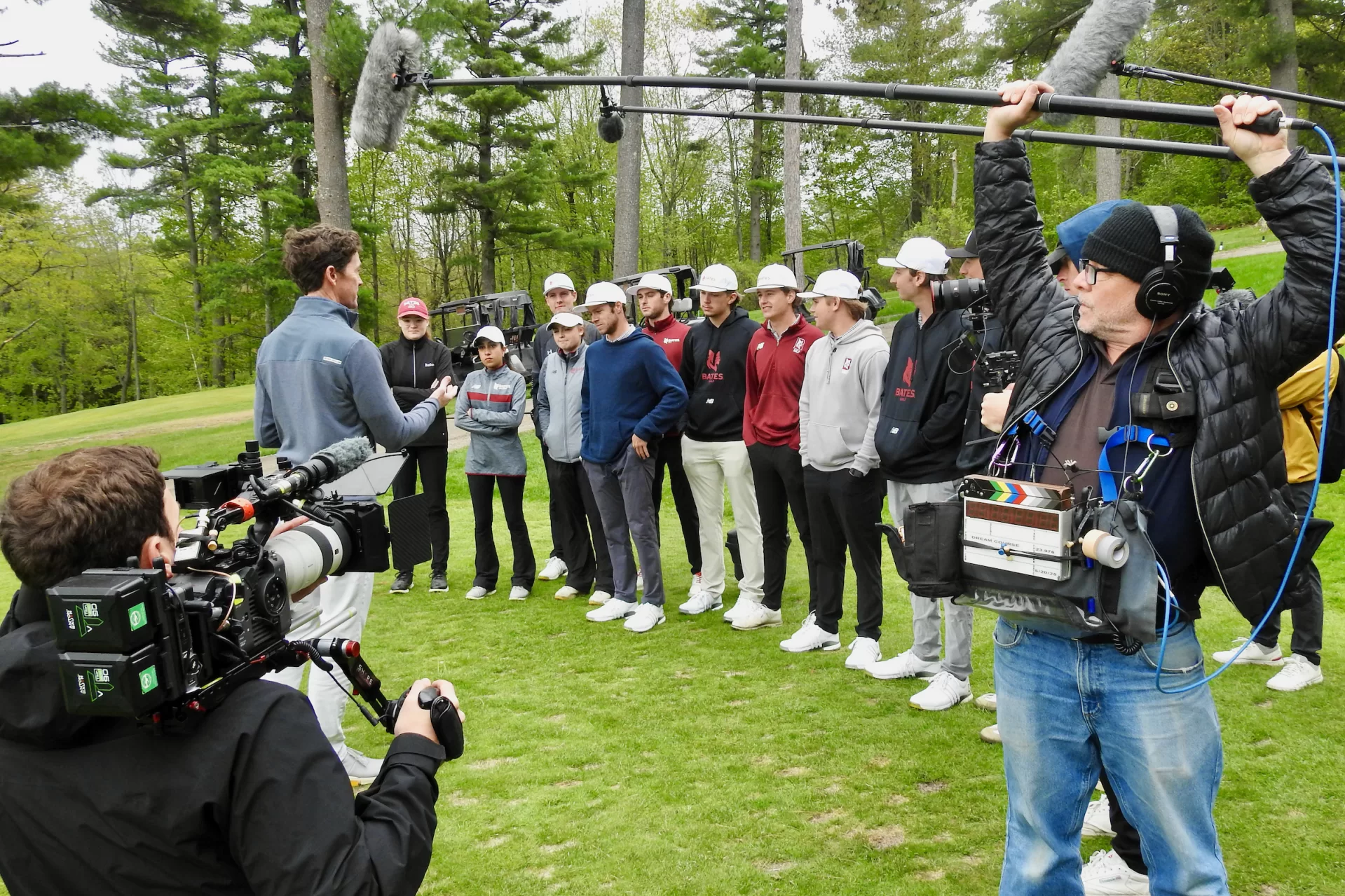
Shot in Lewiston and Auburn on a single day in May, the result is a 12-minute custom feature video sponsored by Adobe that debuted this month, starring many Bates golfers adorned in Bobcat-merch, the Martindale Country Club, and campus locations that included Pettengill Hall’s Perry Atrium.
Bates landed on Golf Digest’s radar through connections with two Bates golfers. The first is a current student, Charlie Weinman ’27, a politics major from Rye, N.Y., whose father, Sam Weinman, is the publication’s digital editorial director.
But Sam Weinman’s connection to Bates predates his parental one. For Golf Digest in 2018, he profiled a teenage golfer, Sam Gerry ’24, who at that time was raising awareness of mental health by drawing on his own experience. Gerry went on to attend Bates and play golf. Over that time, Weinman followed his progress. Then, when Charlie Weinman was first considering Bates, he got a campus tour from Sam Gerry.
During Golf Digest’s brainstorming sessions for the Adobe project, the idea of using a small-college team came up. Weinman said his colleagues “knew that Charlie was having a great experience at Bates.” They included Stina Sternberg, an executive with Warner Bros. Discovery Sports who leads video and branded content for the publication and who ultimately made the call to select the Bobcat team for the Adobe project.
Watch the Golf Digest video:
Filming day was May 20. Production started at Bates’ historic home course, Martindale Country Club in Auburn, then shifted to campus, where the golfers used Firefly to imagine, design, and create realistic visual images of their own golf holes — all in front of a production team capturing their every move.
The weather was familiar Maine “spring” weather: cloudy skies, north winds gusting to 20 mph, and a temperature that barely reached 50 degrees. The day’s first scene focused on one of the course’s signature holes, the par-3 9th hole, a precipitously downhill hole that plays 180 yards from the white tees.
From a storytelling standpoint, it was the perfect place to begin. Since the course opened in 1921, the elevated tee has felt magical. “Climb to the very crest, keep your eyes on the ground until you reach the summit, and then turn around and drink it in,” exhorted the Lewiston Sun Journal in its review of the new Auburn course. (Today Martindale Country Club is owned by Nick Glicos, whose son Evan graduated from Bates in 2024 with an economics degree.)
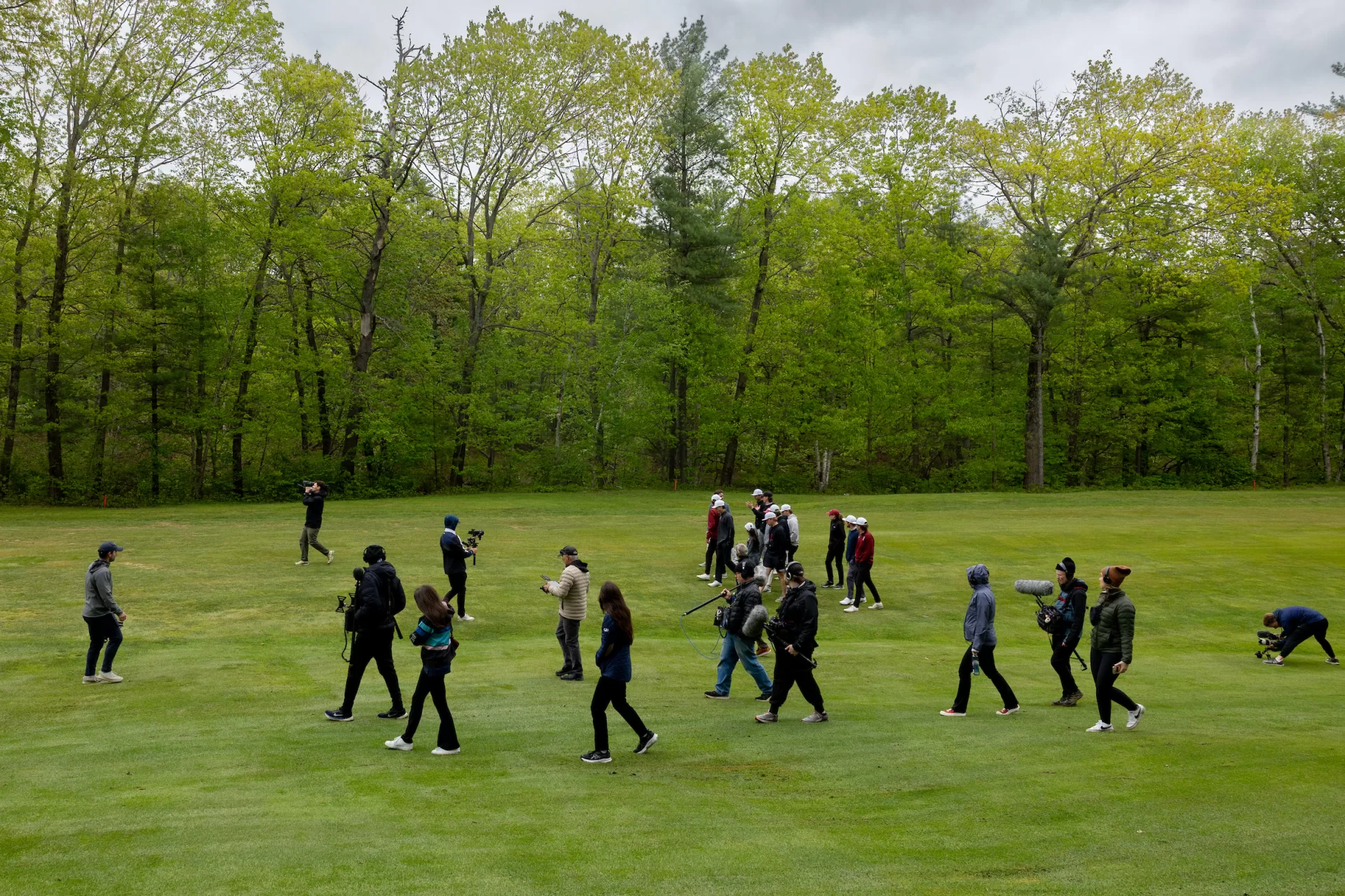
Atop the windy hill, the film crew assumed their positions on the 9th tee. Down below, the Bates golfers were gathered on the green. “Action,” said supervising producer Michael Sneeden, and three handheld cameras captured video, and a drone tracked the action from above, as the golfers completed a cinematic walk up the steep hill. There, they met Derek Duncan, Golf Digest’s architecture editor and host of the podcast Feed the Ball.
With cameras rolling, Duncan offered a historical primer on golf course design. He explained the history and legacy of Charles Blair Macdonald (1855–1939), who studied classic U.K. holes and brought their strategic brilliance to his U.S. designs. “Macdonald had a set of what he considered his ‘ideal’ golf holes, and he worked to design courses from those holes,” he said, referring to Macdonald’s concept of “template holes,” basic layouts that could be tweaked and adapted for any terrain or setting, but that would always be playable, fun, and challenging for all golfers.
“That’s what you will do with Adobe Firefly,” Duncan said. “You’ll use inspirations from holes that you’ve played, some from your own hometown courses, and from your travels. Think about what you like and don’t like about those courses.”
He asked them to look down at the 9th green, which has Beech Hill Road passing right behind the hole. The hole’s design reflects strategic course design: To help the golfer keep the road behind the green out of play, there’s a generous, safe landing area in front of the green.
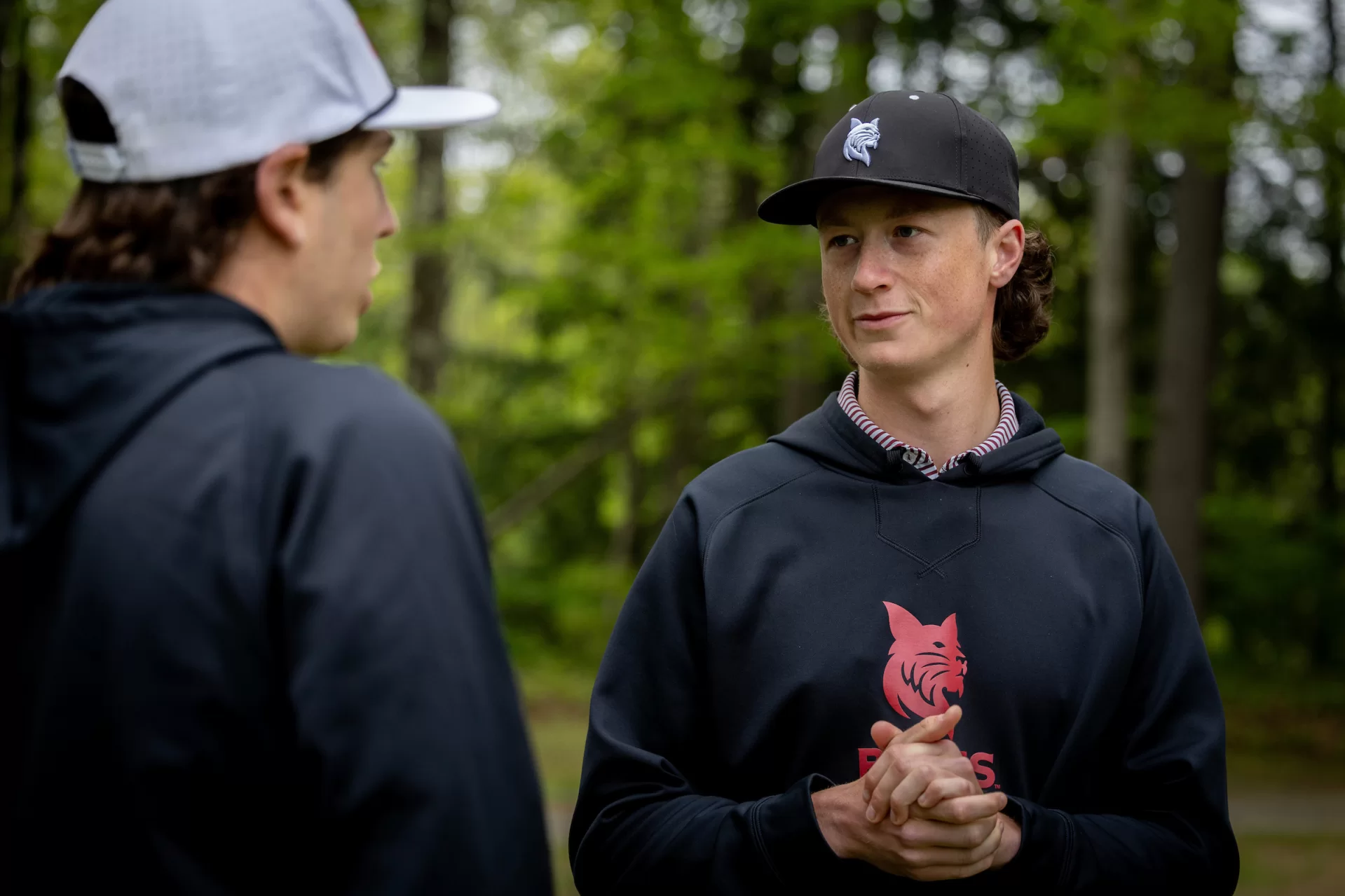
“You don’t want a road to be part of a hole’s strategy, unless you’re talking St. Andrews,” Duncan told the golfers, referring to the famed Road Hole, where a road behind the green and along the right side of the fairway becomes a critical part of a golfer’s decision-making.
From the 9th tee, the production team and the Bates golfers moved to the 12th, a straight 484-yard par 5 where a right-handed golfer could slice the ball into the Little Androscoggin River that runs alongside the fairway.
As Duncan walked the 12th fairway and talked with the Bates golfers, the 16-member production team — camera and audio operators, drone specialists, producers, directors, and executives — moved in a loose orbit around them. The video team came from IMG Media, based in London, with freelance professionals capturing audio.

Duncan asked what made the hole challenging. “It’s just so straight,” said one Bates golfer. As they advanced down the fairway, team captain Will Phillips ’25 of Portland, Ore., took note of Duncan’s approach to the course, which was instructive beyond golf.
“It’s the way he walks a golf course: He walks slow, and he takes time to look at all the undulations in the green, to look at where a good miss might be off the tee.” (A “good miss” is a shot that misses the golfer’s intended mark but doesn’t find deep trouble.) “He takes his time to gather in what is all around him before he makes any remarks or gives his opinion.”
For Phillips, the morning exercise at Martindale turned the typical golf experience inside out. Like other individual sports, golf demands an inward focus. But like only a handful of other sports, such as skiing or running cross country, golf’s playing venue changes dramatically with each match, which tests the golfer’s ability to stay focused, block out distractions, and make smart decisions under pressure.
“We just came off our season,” explained Phillips. “Practice, practice, practice, and play, play, play. You work to get comfortable with yourself in your own head. You find little techniques to stay on it mentally.”

But as Phillips walked the Martindale golf course with Duncan, he realized that to view the course as a creative course designer, he needed to step outside “the player mentality and into the designer mentality, and visit the game of golf without having to be completely locked in, dialed in, and focused on yourself.”
His teammate, Henry Ehrlich ’26, also from Portland, Ore., was similarly struck by how Duncan invited the group to shift their thinking. Duncan asked the golfers to imagine how any given hole might be different, and how that would affect someone’s experience.
“When you’re on the course as a golfer, it’s such a mental sport. It’s so easy to get in your own head,” Ehrlich said. “Thinking about the way the course is constructed and how everything’s laid out isn’t something that’s always at the top of your mind.”
“You gave us gold. You blew all of us away with your engagement, enthusiasm, smart questions and answers, and, yes, design skills.” — Stina Sternberg, Warner Bros. Discovery Sports
For example, said Ehrlich, when he’s on Martindale’s 9th tee, “minus wind, I’ll hit the same club no matter what. I know where I’m going to be, because I’d rather be short in that collection area than be long.” (That’s an example of the “good miss.”) “When you realize that the hole is designed for that purpose, that it’s how you’re supposed to play the hole, the architecture makes more sense.”
At its heart, a liberal arts education teaches students to ask the question “why,” and that played out even during the experience of starring in an advertising product. Mehar Nijjer ’27, a psychology major from Chandigarh, India, said that her mindset on the tee would typically be focused on tactics. “Hit the ball to this target, avoid that hazard.”

Now, she has “why” in mind. “I’m thinking much more about strategy and the architect’s intended path. I ask questions like, ‘Why is this bunker here? What is the best angle of attack to this green, and why?’ It’s no longer just about hitting a good shot but about hitting the right shot for the situation, based on a deeper understanding of the hole’s design.”
Her teammate Isabelle Meltzer ’28 of Summit, N.J., agrees. “A big part of scoring in golf is being good at course management — taking into account shot shapes, risk vs. reward for certain shapes, and where to place balls on the green. Walking the course gave me more things to think about when it comes to where I want to be on a green or fairway in a competition.”
After the morning at Martindale, everyone headed back to Perry Atrium in Pettengill Hall where the Bates golfers broke into groups and used what they saw and heard from Duncan to take a crack at designing their own golf holes using Adobe Firefly.
During a break in the afternoon shooting, Michael Sneeden, the project’s supervising producer, was asked what the Bates students were bringing to the project. He used the example of a Venn diagram, how a series of circles might explain a video project that uses volunteer student talent.
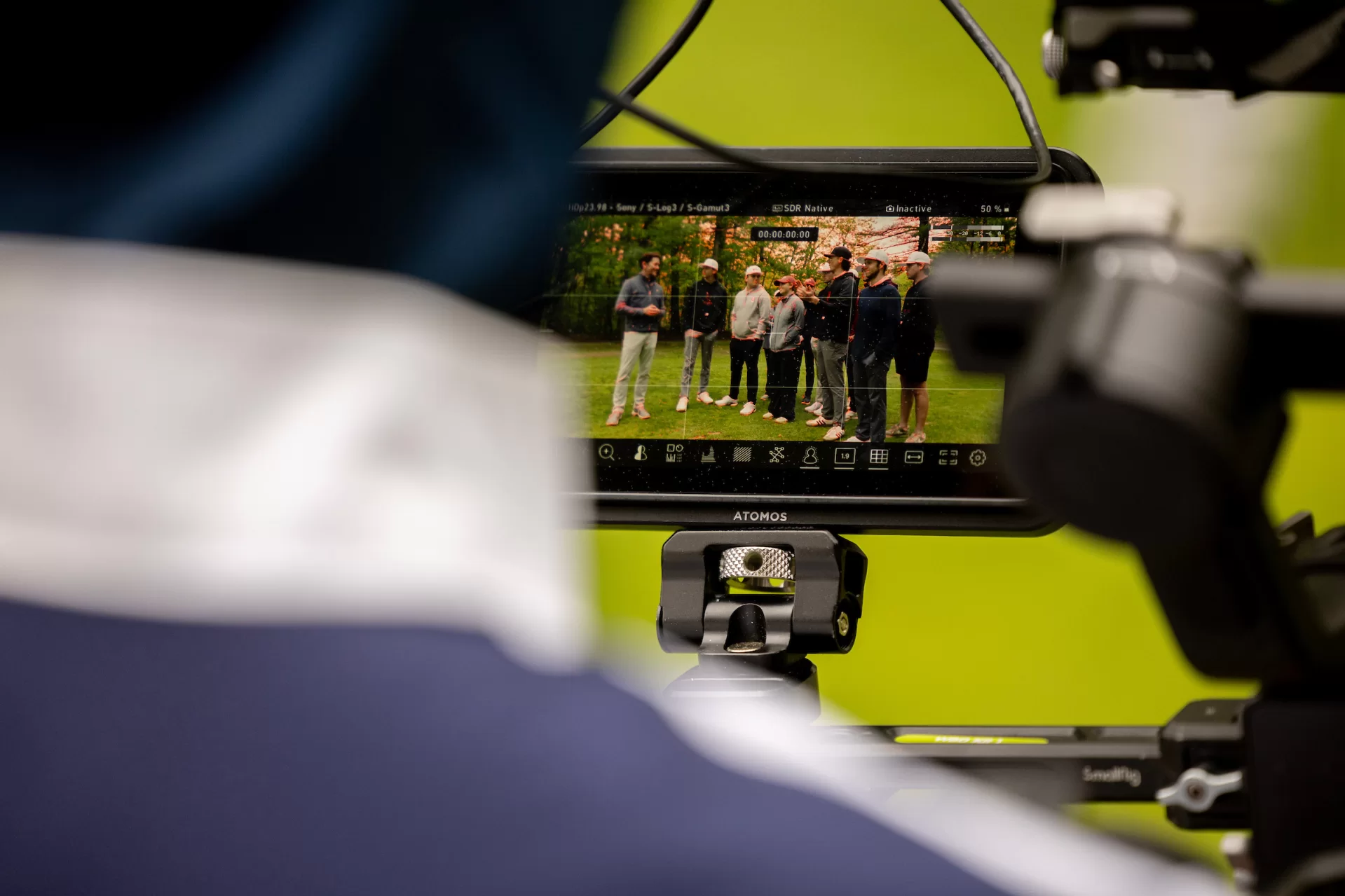
Sneeden rattled off the circles of need. One, of course, was being top-flight golfers “at a great college.” Then being available and willing to give their time, the ability to “take physical direction as we move the cameras around,” and, finally, the ability to speak on camera, “thoughtfully, respectfully, and intelligently.”
Like other Adobe products such as Photoshop and Illustrator, Firefly enables users to create and enhance visual content. It uses generative AI, which means users can produce images, including text effects and other visual attributes, by typing a text description. The Bates students also used Firefly Boards, a collaborative tool to help with the overall ideation.
Phillips’ team took a crack at designing a variation of the par-3 12th hole at Augusta National Golf Club, home of the Masters. First, they used Adobe Fresco, a free drawing tool, to make rough sketches, then used Firefly to make the hole look real, with lush greens, swaying trees, and a vivid water hazard fronting the green. They didn’t touch the iconic green, but instead imagined new tee boxes. “We gave them four new options, differing yardages, which creates more or less of a battle with that traditional angle across the green.”
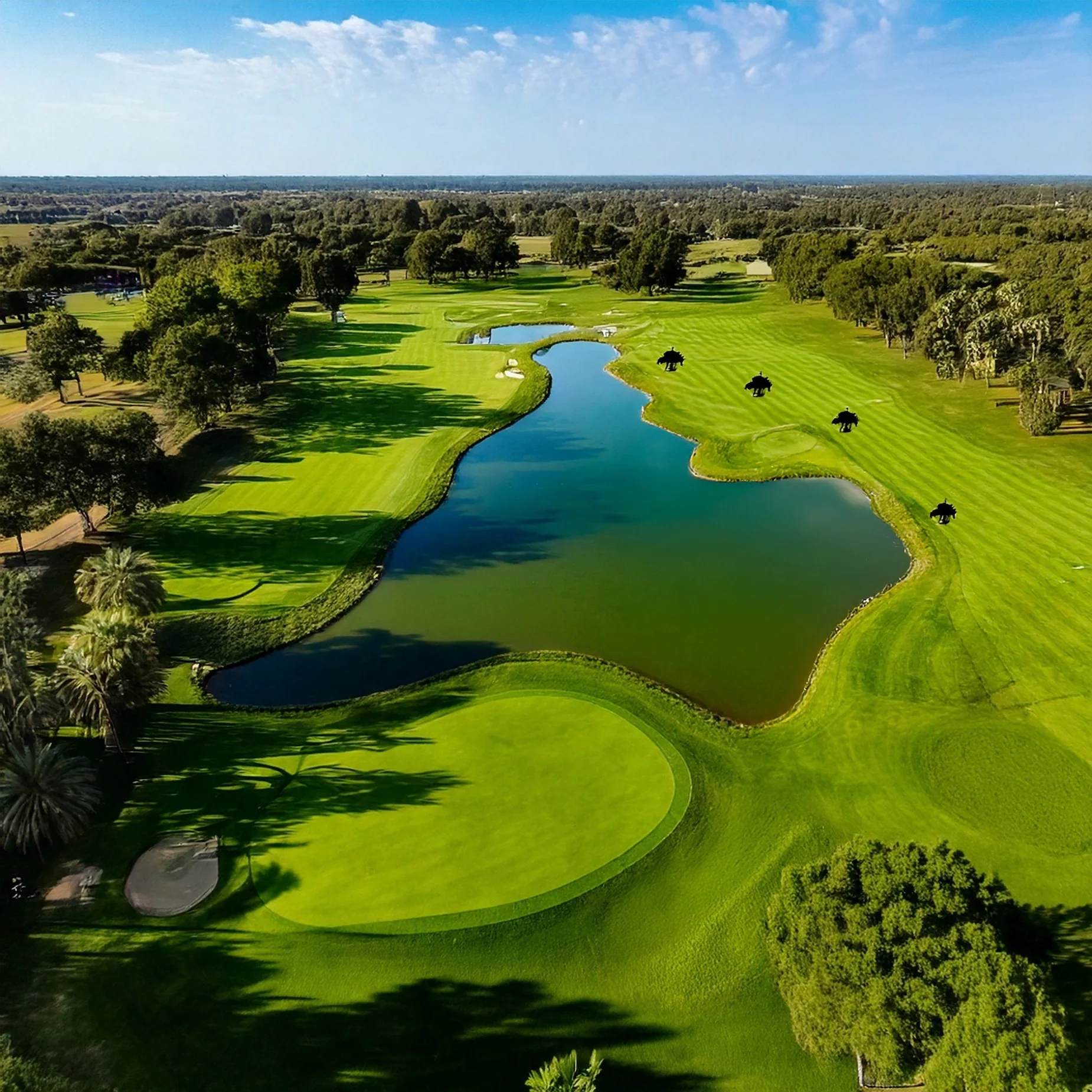
Meanwhile, Nijjer found inspiration from across the country, designing a dogleg-right par 5 that features stunning redwood trees sometimes found on northern California courses like Northwood Golf Club in Monte Rio. “We felt this provided a unique and scenic element that is not often seen in golf course architecture,” she said. “A key element was ensuring the hole was accessible and engaging for golfers of all abilities.”
That’s what the Golf Digest team wanted to see. “The engagement from the Bates golfers comes a lot from the fact that they’re so genuine,” said Sneeden.
Since 2021, NCAA student-athletes can profit from their name, image, and likeness (NIL) through endorsement deals and other business ventures. At the Division I level, this means millions going to top athletes.

“They’re making a ton of money, which means they often already have media training by the time they get to college,” said Sneeden.
What the Golf Digest team found at Bates was golfing excellence among the men and women on the golf team. “They’re going to be professional in their fields, just not professional golfers. They gave us their honest opinions, not something manufactured.”
Or as Stina Sternberg put it in a thank you note to the golfers: “You gave us gold. You blew all of us away with your engagement, enthusiasm, smart questions and answers, and, yes, design skills.”
Jay Burns recently retired from Bates Communications and Marketing after a 32-year career that included many titles and ended with senior editorial director. He edited Bates Magazine for much of his career at Bates and will continue to contribute to the college’s publications as a freelancer.
